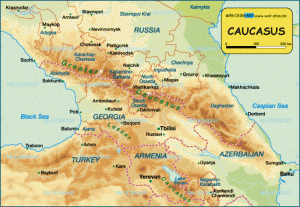 After my visit to South Caucasus in 2011, I am keen to see North Caucasus, the northern part of the Caucasus region between the Black and Caspian Seas and within European Russia. This region has been synonym for trouble and terrorism and is off the normal tourist trail. When Peter announced his plan last year to organise a tour to North-Ossetia, Ingushetia, Chechnya and Dagestan, I joined without hesitation.
After my visit to South Caucasus in 2011, I am keen to see North Caucasus, the northern part of the Caucasus region between the Black and Caspian Seas and within European Russia. This region has been synonym for trouble and terrorism and is off the normal tourist trail. When Peter announced his plan last year to organise a tour to North-Ossetia, Ingushetia, Chechnya and Dagestan, I joined without hesitation.
Background
Russia is the world’s largest country (over 17 million square kilometres) with a population of 143 million. Under the Constitution of Russia, the country consists of 83 federal subjects (i.e. constitute entities) including 21 republics 46 oblasts(provinces), 9 Krais (territories), 1 autonomous krai, 4 autonomous okrugs (districts) and 2 federal cities. Its 160 ethnic groups speak some 100 languages.
Politically, the Northern Caucasus region consists of Krasnodar Krai, Stavropol Krai, and the Republic of Adygea, Karachay-Cherkessia, Kabardino-Balkaria, North-Ossetia-Alania, Ingushetia, Chechnya, and Dagestan. Republics are nominally autonomous; each has its own constitution and legislature and is home to a specific ethnic minority. Islam was introduction in the region in the 17th century. Peter the Great made his way to the region which became part of the Russian Empire by the 18th century.
Conflicts and insurgency in the region can be traced back to the policies and development since the Soviet era. Chechnya has been the most troublesome spot. In late 1930s, Chechnya and Ingushetia were combined to form an autonomous republic. Chechens rose up against Soviet rule in 1940. On February 23, 1944, Stalin ordered almost 500,000 Chechen and Ingush people who had purportedly lent support to German forces to go to Kazakhstan and Siberia. The Chechens were allowed to return to their ‘own ethnic land’ after 1956 under the new leader, Khrushchev. The huge loss of life, long suffering and rising nationalism explain Chechnya’s problem with the Russian government.
Chechen separatists declared independence in early 1990s. The area has since been in a near constant state of war between the rebel groups and Russian military. The Chechen terrorists shocked the world during the Moscow theatre hostage crisis in 2002 and the Beslan school siege in North Ossetia in 2004. Thousands of Chechens fled the area as refugees causing problems in North Ossetia, Ingushetia and Dagestan. Despite the official end of the Second Chechnya War in 2009, insurgency continues and clashes and bombings occur from time to time.
The dissolution of the Soviet Union has also caused problems to the Ossetian people who were divided between North Ossetia and South Ossetia. The latter was incorporated into Georgia. Some 70,000 South Ossetian refugees fled to North Ossetia in Russia amidst rising ethnic tensions. This sparked off clashes with the predominantly Ingush population in the Prigorodny District leading to the Ossetian-Ingush conflict.
|
Area(m²) |
Population* |
People* |
Religion* |
|
| North Ossetia-Alania |
8,000 |
712,980 |
Ossetians:65.1%; Russians:20.8%; Ingushes:4% |
Orthodox:51.2%; Osset paganism:29% Islam:4% |
| Ingushetia |
4,000 |
467,294 |
Ingushes:94.1%; Chechens: 4.6% |
Islam (majority) |
| Chechnya |
15,300 |
1,103,686 |
Chechens:95.3%; Russians:1.9% |
Islam (majority) |
| Dagestan | 50,300
|
2,576,531 |
Avars:29.4%; Dargins:17% Kumyks:14.9%; Lezgians:13.3%
|
Islam: 83%; Russian Orthodox:4% |
(Source: Wikipedia; * based on 2010 Census)
June 28 Friday: Vladikavkaz
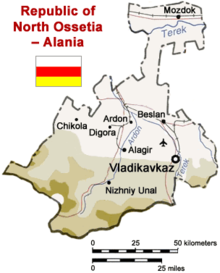 Vladikavkaz founded in 1784 as a fortress during the Russian conquest of the Caucasus is the capital city of the Republic of North Ossetia-Alania. Situated on the Terek River and located at the foothills of the Caucasus Mountains, Vladikavkaz, an important industrial centre for the region has a population of over 311,000 (2010 Census). The Georgian Military Highway constructed in 1799 links the city with Georgia to the south and a railway was built in 1875 to connect it to Rostov-on-Don and Baku in Azerbaijan. Owing to its strategic location, it was fought over in the Russian Civil War and the forces of Nazi Germany were repelled from the city in November 1942 during the World War II.
Vladikavkaz founded in 1784 as a fortress during the Russian conquest of the Caucasus is the capital city of the Republic of North Ossetia-Alania. Situated on the Terek River and located at the foothills of the Caucasus Mountains, Vladikavkaz, an important industrial centre for the region has a population of over 311,000 (2010 Census). The Georgian Military Highway constructed in 1799 links the city with Georgia to the south and a railway was built in 1875 to connect it to Rostov-on-Don and Baku in Azerbaijan. Owing to its strategic location, it was fought over in the Russian Civil War and the forces of Nazi Germany were repelled from the city in November 1942 during the World War II.
I arrived at the Vladikavkaz railway station at 9:20am and took a taxi to Hotel Planet Lux. I stayed in the hotel waiting for my group from Hong Kong. At 1:30pm, I called Olga (our Russian contact) to find out what had happened to the group. She apparently was not aware that I had arrived on my own. She said that the plane was delayed and the group had just landed. I expected the group to arrive soon but no one appeared two hours later. I called Olga again and was told that the group had gone sight-seeing and dinner would be served at 6pm! I was upset as I had wasted the whole day in the hotel. Had I known the group would be visiting the “City of Angels” (a grave site) on the way to the hotel, I could have gone to the airport to meet up with the group.
Vladikavkaz was a target of bombings in 1999, 2008 and 2010 and caught world’s attention when a group of armed Islamic separatist militants mostly Ingush and Chechen occupied School No 1 in Beslan on September 1, 2004 demanding recognition of the independence of Chechnya at the UN and Russian withdrawal from Chechnya. Over 1,100 people including 777 children were taken as hostages. On September 4, Russian security forces entered the building with the use of heavy weapons. As a result, 335 hostages including 186 children were killed. This tragedy led to an outcry against excessive use of forces and security and political repercussions in Russia.
I was bored and went out for a walk at 4pm. I could not find any map and the receptionist suggested me visit the city park by the river. I had a lovely walk, visited a mosque where I met several young ladies with kids. The city centre is small and the Avenue of Peace is leafy and charming with rows of 19th century buildings. Many restored buildings are painted in red, orange, green, blue and white colours. I watched old trams moving slowly with locals getting on and off. This tranquil and undisturbed place resembles a street scene in movie.
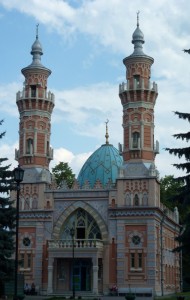 |
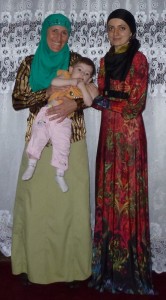 |
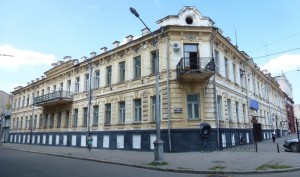 |
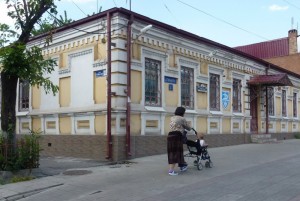 |
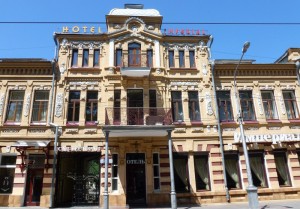 |
I returned to the hotel and met Olga, a trip planner from Vladivostok who coordinated this trip, Peter, our tour leader and 28 participants from Hong Kong. I was glad to see many old friends including Peter, Kylie, my room-mate during our trip to Iraq in 2011, YY and On who organised the trip to Yellowknife, Canada to watch Northern Lights and Stephen, my former colleague and our professional photographer.
June 29 Saturday: Excursion
Our hotel built during the Soviet era is comfortable but noisy. I had the windows open and was disturbed by the traffic noise. We set off at 9am for the 50km-long Kurtat Gorge with our local guide, George. The coach travelled on the Georgia Military Road across the Caucasus Mountains. We had a couple of photo stops with good views of the mountains, stone watch towers and villages.
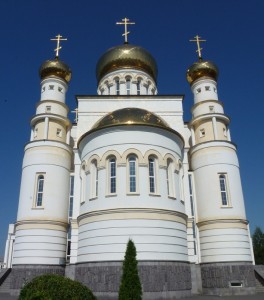 |
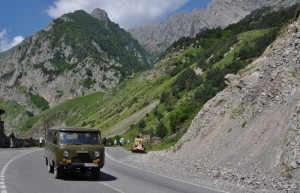 |
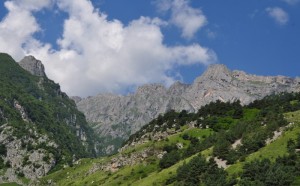 |
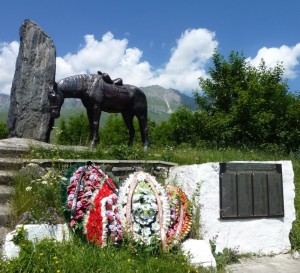 |
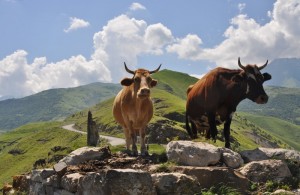 |
Before lunch, we followed a trail to reach a ‘City of Dead’ in Tsumti, the site which we first sighted from the other side of the valley. It was a tradition in this region to erect brick burial crypt for the family. We even saw some bones in a crypt the top of which has collapsed.
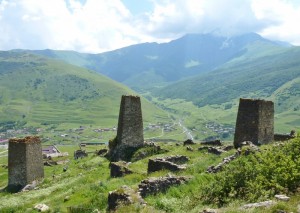 |
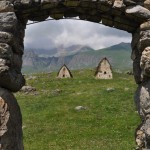 |
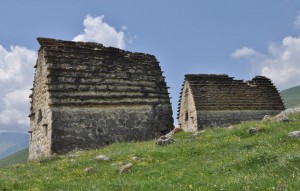 |
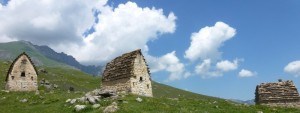 |
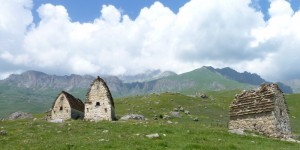 |
We had a delicious lunch in a garden restaurant. Before returning to the city, we visited the Alansky Epiphany Monastery. The weather changed quickly and it began to rain.
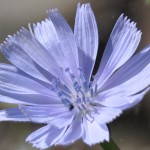 |
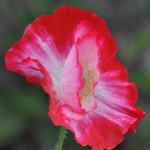 |
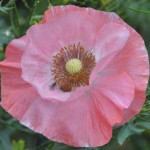 |
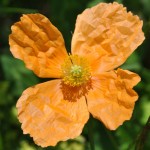 |
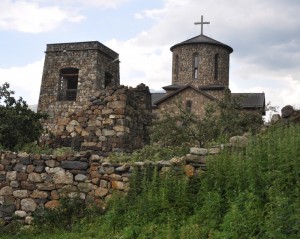 |
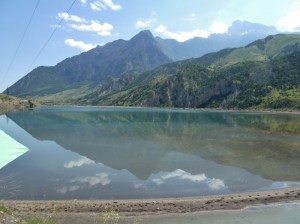 |
George took us to the Ethnographic Museum which was once a printing house and home of the owner of a newspaper. The exhibits including, printing machines, a carriage used during the Civil War, a piano, household goods and clothes are well preserved and presented.
As it was Mrs. Gu’s birthday, we had a surprise drink party in a Georgia wine bar with live music. We had a great evening with birthday cake and wine.
June 30 Sunday: Excursion
According to the original programme, we would be visiting Dargavsk which is known for its historical and architectural complex of the eponymous village and had lunch in Koban. Owing to poor road condition, our coach could not go to Dargavsk. Instead, we headed to the Skazskiy Glacier which is known for its magnificent alpine scenery.
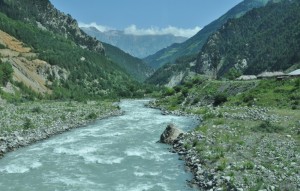 |
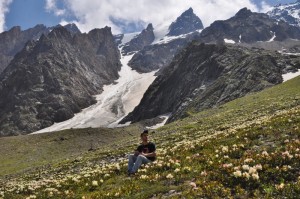 |
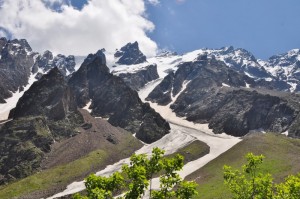 |
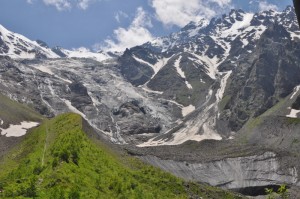 |
The weather was nice and hot. We first took a chairlift and then walked to the bottom of the glacier. Accompanied by Vale, son of the owner of the travel company, I had a fun time. Vale gave me a hand and I walked along a narrow ridge with deep slopes on both sides. Vale also took many pictures for me. The topography reminds me of Kyrgyzstan but it is on a smaller scale.
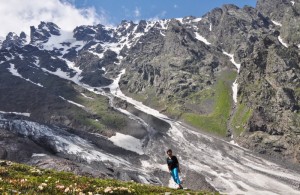 |
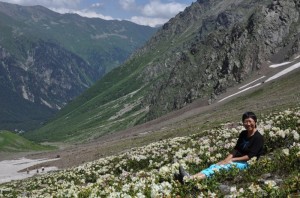 |
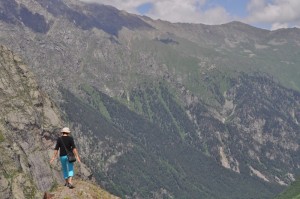 |
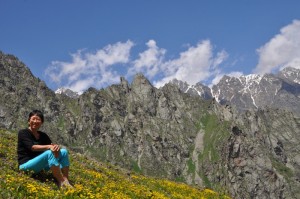 |
After lunch, we were taken to a nunnery which also runs an orphanage. I drank the holy water from the St Nicholas’s spring. Some 20 nuns aging between 80 and 16 live there.
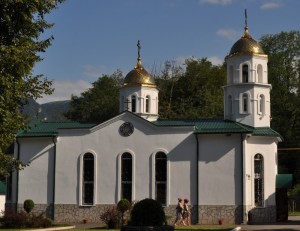 |
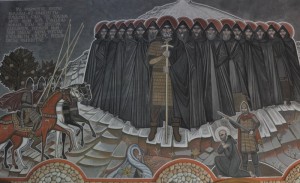 |
In the evening, we had dinner in a local restaurant serving Ossetic and Russian cuisine. Vale brought his lovely girlfriend along. We had a fantastic evening with delicious local cuisine, music, folk dance and singing.
July 1 Monday: Vladikavkaz, North Ossetia – Ingushetia
We had a walking tour from 9am to 1pm. We started off at the left bank of River Terek. After crossing the river, we arrived at the oldest part of the city on the right bank of the river. The blue-and-white Orthodox Church with a graveyard for prominent figures of the city on the hillside affords a good view of the city.
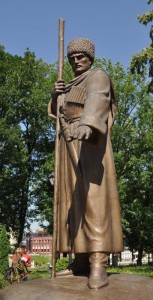 |
Our third stop was the Armenia Church (1868) which has a plague commemorating the genocide by the Turks in 1915. Then we strolled along the picturesque Avenue of Peace taking pictures of the charming old buildings. Our final stop was the Central Market. I had a fun time drinking local beer and sampling caviar, smoked chicken and grilled beef.


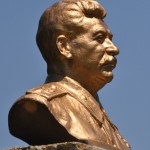
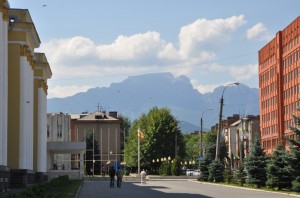
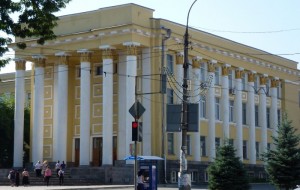
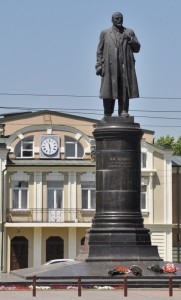
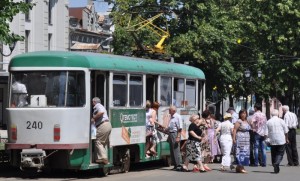
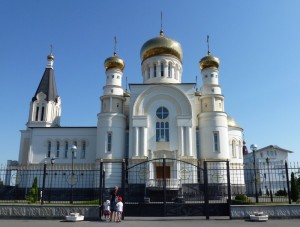
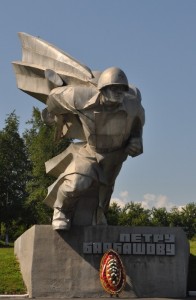
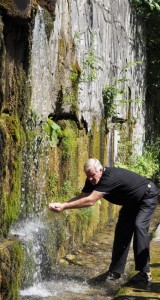
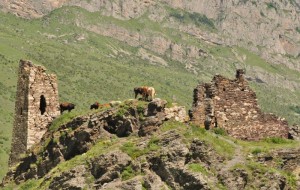
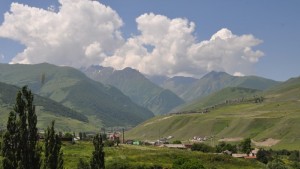
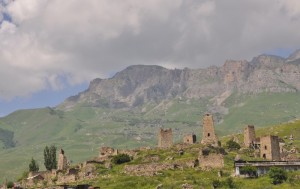
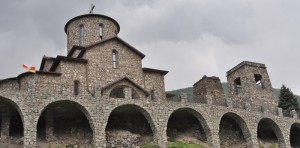
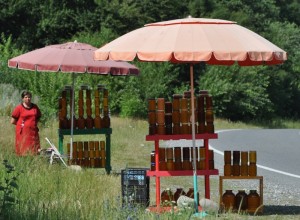
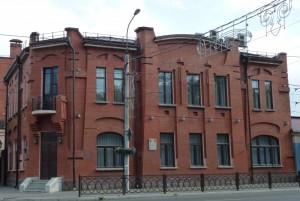
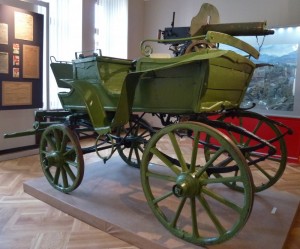

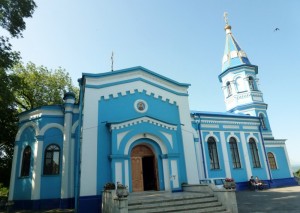
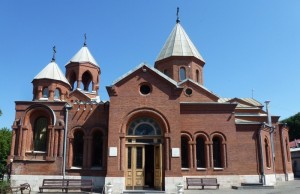
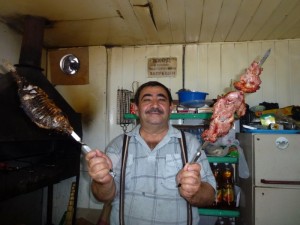
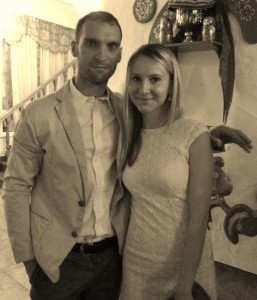
hope u got something interesting in South Osetia, waiting for exposition.
Vale
Sarah, please throw my photos: maryosman@yandex.ru